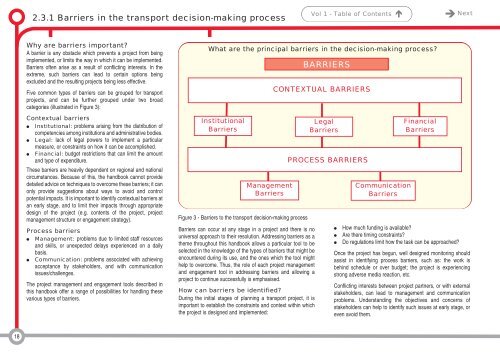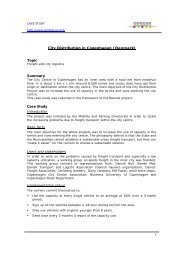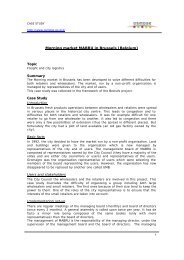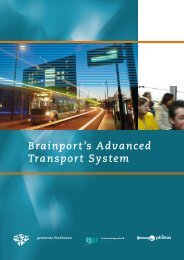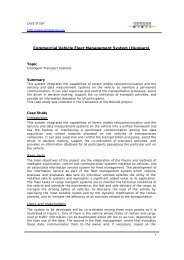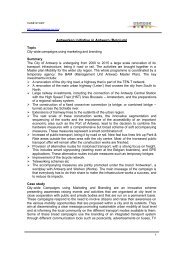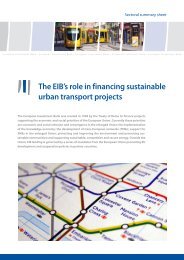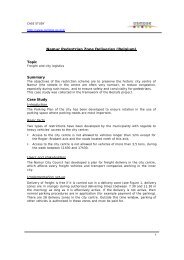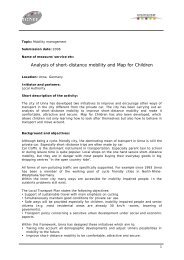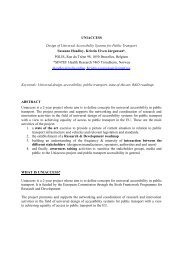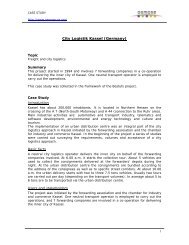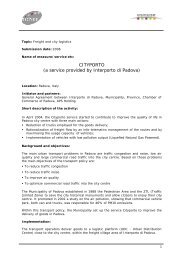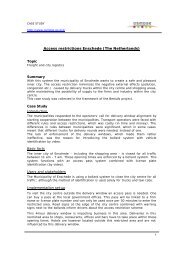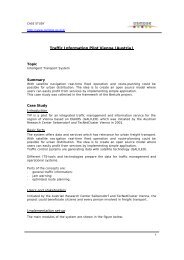Successful transport decision-making - Osmose
Successful transport decision-making - Osmose
Successful transport decision-making - Osmose
Create successful ePaper yourself
Turn your PDF publications into a flip-book with our unique Google optimized e-Paper software.
2.3.1 Barriers in the <strong>transport</strong> <strong>decision</strong>-<strong>making</strong> process<br />
Vol 1 - Table of Contents <br />
Next<br />
Why are barriers important?<br />
A barrier is any obstacle which prevents a project from being<br />
implemented, or limits the way in which it can be implemented.<br />
Barriers often arise as a result of conflicting interests. In the<br />
extreme, such barriers can lead to certain options being<br />
excluded and the resulting projects being less effective.<br />
Five common types of barriers can be grouped for <strong>transport</strong><br />
projects, and can be further grouped under two broad<br />
categories (illustrated in Figure 3):<br />
Contextual barriers<br />
Institutional: problems arising from the distribution of<br />
competencies among institutions and administrative bodies.<br />
Legal: lack of legal powers to implement a particular<br />
measure, or constraints on how it can be accomplished.<br />
Financial: budget restrictions that can limit the amount<br />
and type of expenditure.<br />
These barriers are heavily dependent on regional and national<br />
circumstances. Because of this, the handbook cannot provide<br />
detailed advice on techniques to overcome these barriers; it can<br />
only provide suggestions about ways to avoid and control<br />
potential impacts. It is important to identify contextual barriers at<br />
an early stage, and to limit their impacts through appropriate<br />
design of the project (e.g. contents of the project, project<br />
management structure or engagement strategy).<br />
Process barriers<br />
Management: problems due to limited staff resources<br />
and skills, or unexpected delays experienced on a daily<br />
basis.<br />
Communication: problems associated with achieving<br />
acceptance by stakeholders, and with communication<br />
issues/challenges.<br />
The project management and engagement tools described in<br />
this handbook offer a range of possibilities for handling these<br />
various types of barriers.<br />
What are the principal barriers in the <strong>decision</strong>-<strong>making</strong> process?<br />
Institutional<br />
Barriers<br />
Management<br />
Barriers<br />
Figure 3 - Barriers to the <strong>transport</strong> <strong>decision</strong>-<strong>making</strong> process<br />
Barriers can occur at any stage in a project and there is no<br />
universal approach to their resolution. Addressing barriers as a<br />
theme throughout this handbook allows a particular tool to be<br />
selected in the knowledge of the types of barriers that might be<br />
encountered during its use, and the ones which the tool might<br />
help to overcome. Thus, the role of each project management<br />
and engagement tool in addressing barriers and allowing a<br />
project to continue successfully is emphasised.<br />
How can barriers be identified?<br />
During the initial stages of planning a <strong>transport</strong> project, it is<br />
important to establish the constraints and context within which<br />
the project is designed and implemented:<br />
BARRIERS<br />
CONTEXTUAL BARRIERS<br />
Legal<br />
Barriers<br />
PROCESS BARRIERS<br />
<br />
<br />
<br />
Communication<br />
Barriers<br />
Financial<br />
Barriers<br />
How much funding is available?<br />
Are there timing constraints?<br />
Do regulations limit how the task can be approached?<br />
Once the project has begun, well designed monitoring should<br />
assist in identifying process barriers, such as: the work is<br />
behind schedule or over budget; the project is experiencing<br />
strong adverse media reaction, etc.<br />
Conflicting interests between project partners, or with external<br />
stakeholders, can lead to management and communication<br />
problems. Understanding the objectives and concerns of<br />
stakeholders can help to identify such issues at early stage, or<br />
even avoid them.<br />
18


